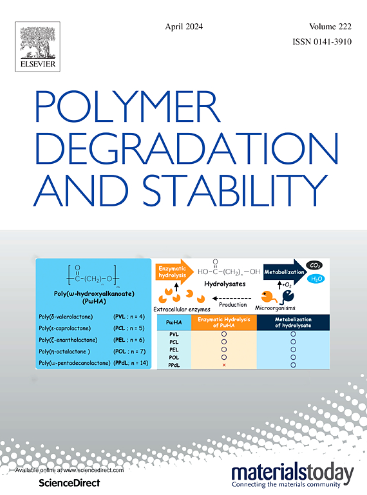Constructing a carborane-hybridized cross-linked network endows phenolic resin with excellent structural thermo-oxidative and ablative resistant
IF 6.3
2区 化学
Q1 POLYMER SCIENCE
引用次数: 0
Abstract
Phenolic resin (PR) has been widely used in ablative thermal protection systems for aerospace applications, but improving its thermo-oxidative and ablation resistance remains challenging. PR hybrid resin with excellent thermal-oxidative resistance was designed through introducing carborane (CB) into the cross-linked network structure of PR. CB hybrid phenolic resin (CBPR) displayed an impressive heat resistance and carbonization, the initial thermal decomposition temperature (T5 %) and weight residue at 800 °C (R800 °C) of CBPR0.4 in N2 were 566.3 °C and 85.45 %, and those were 494.5 °C and 79.74 % in air. It was related to the fact that CB could consume free radicals, inhibit cross-linking network destruction, promote organic-inorganic hybrid structures generation and slow down decomposition rate. Meanwhile, PR hybrid resin possessed outstanding oxyacetylene ablation performance, the linear ablation rate (LAR) and mass ablation rate (MAR) were only 0.0015 mm/s and 0.0375 g/s due to in-situ ceramicization and graphitization during ablation, which were reduced by 98.26 % and 71.88 %. The results of this study would provide some inspirations for the development of high-performance thermally protective materials in the future.

碳硼烷杂化交联网络的构建使酚醛树脂具有优良的结构、耐热氧化性和耐烧蚀性
酚醛树脂(PR)已广泛应用于航空航天领域的烧蚀热防护系统中,但提高其抗热氧化性和抗烧蚀性仍然是一个挑战。通过在PR交联网络结构中引入碳硼烷(CB),设计了具有优异耐热氧化性能的PR杂化树脂。CB杂化酚醛树脂(CBPR)表现出良好的耐热性和炭化性能,CBPR0.4在N2中初始热分解温度(T5 %)和800℃时的重量残渣(R800℃)分别为566.3℃和85.45%,在空气中初始热分解温度(T5 %)和重量残渣分别为494.5℃和79.74%。这与CB能够消耗自由基,抑制交联网络破坏,促进有机-无机杂化结构的生成,减缓分解速率有关。同时,PR杂化树脂具有优异的氧乙炔烧蚀性能,烧蚀过程中由于原位陶化和石墨化,线性烧蚀率(LAR)和质量烧蚀率(MAR)分别为0.0015 mm/s和0.0375 g/s,分别降低了98.26%和71.88%。本研究结果将为今后高性能热防护材料的开发提供一定的启示。
本文章由计算机程序翻译,如有差异,请以英文原文为准。
求助全文
约1分钟内获得全文
求助全文
来源期刊

Polymer Degradation and Stability
化学-高分子科学
CiteScore
10.10
自引率
10.20%
发文量
325
审稿时长
23 days
期刊介绍:
Polymer Degradation and Stability deals with the degradation reactions and their control which are a major preoccupation of practitioners of the many and diverse aspects of modern polymer technology.
Deteriorative reactions occur during processing, when polymers are subjected to heat, oxygen and mechanical stress, and during the useful life of the materials when oxygen and sunlight are the most important degradative agencies. In more specialised applications, degradation may be induced by high energy radiation, ozone, atmospheric pollutants, mechanical stress, biological action, hydrolysis and many other influences. The mechanisms of these reactions and stabilisation processes must be understood if the technology and application of polymers are to continue to advance. The reporting of investigations of this kind is therefore a major function of this journal.
However there are also new developments in polymer technology in which degradation processes find positive applications. For example, photodegradable plastics are now available, the recycling of polymeric products will become increasingly important, degradation and combustion studies are involved in the definition of the fire hazards which are associated with polymeric materials and the microelectronics industry is vitally dependent upon polymer degradation in the manufacture of its circuitry. Polymer properties may also be improved by processes like curing and grafting, the chemistry of which can be closely related to that which causes physical deterioration in other circumstances.
 求助内容:
求助内容: 应助结果提醒方式:
应助结果提醒方式:


